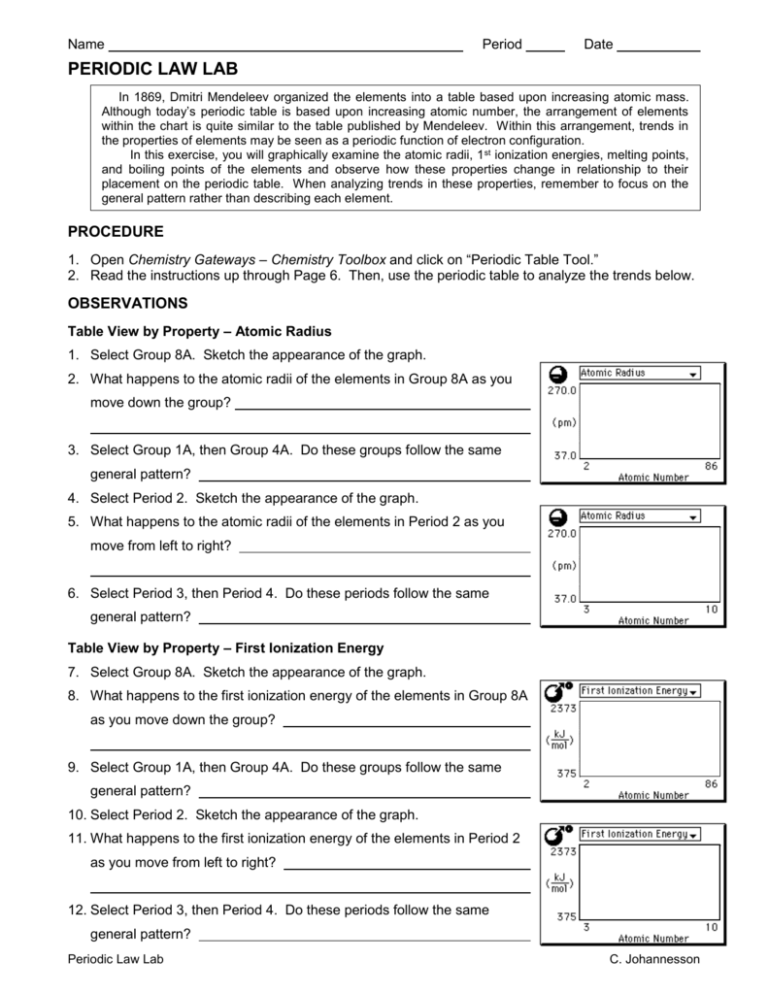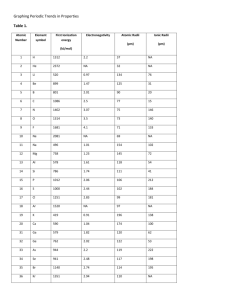Periodic Law - mrsj.exofire.net
advertisement

Name Period Date PERIODIC LAW LAB In 1869, Dmitri Mendeleev organized the elements into a table based upon increasing atomic mass. Although today’s periodic table is based upon increasing atomic number, the arrangement of elements within the chart is quite similar to the table published by Mendeleev. Within this arrangement, trends in the properties of elements may be seen as a periodic function of electron configuration. In this exercise, you will graphically examine the atomic radii, 1 st ionization energies, melting points, and boiling points of the elements and observe how these properties change in relationship to their placement on the periodic table. When analyzing trends in these properties, remember to focus on the general pattern rather than describing each element. PROCEDURE 1. Open Chemistry Gateways – Chemistry Toolbox and click on “Periodic Table Tool.” 2. Read the instructions up through Page 6. Then, use the periodic table to analyze the trends below. OBSERVATIONS Table View by Property – Atomic Radius 1. Select Group 8A. Sketch the appearance of the graph. 2. What happens to the atomic radii of the elements in Group 8A as you move down the group? 3. Select Group 1A, then Group 4A. Do these groups follow the same general pattern? 4. Select Period 2. Sketch the appearance of the graph. 5. What happens to the atomic radii of the elements in Period 2 as you move from left to right? 6. Select Period 3, then Period 4. Do these periods follow the same general pattern? Table View by Property – First Ionization Energy 7. Select Group 8A. Sketch the appearance of the graph. 8. What happens to the first ionization energy of the elements in Group 8A as you move down the group? 9. Select Group 1A, then Group 4A. Do these groups follow the same general pattern? 10. Select Period 2. Sketch the appearance of the graph. 11. What happens to the first ionization energy of the elements in Period 2 as you move from left to right? 12. Select Period 3, then Period 4. Do these periods follow the same general pattern? Periodic Law Lab C. Johannesson 13. Select the elements from Lithium (3) to Argon (18). Note that within each gradual rise, there are two small peaks. Which elements correspond to these small peaks in first ionization energy? 14. Select Period 4, then Period 5. Which elements correspond to the small peaks within each period? Table View by Property – Melting Point & Boiling Point 15. Melting point and boiling point show similar periodic trends. Select various periods for these two properties. 16. How do melting point and boiling point change as you move from left to right across a period? CONCLUSIONS (Answer in the space below.) For both atomic radius and first ionization energy, describe the directions in which the properties increase in value. (Up or down a group? To the left or right across a period?) What relationship exists between the trends for atomic radius and first ionization energy? Consider the valence electron configurations of the elements you identified in Analysis 13 & 14. Why do you think these elements have higher than average first ionization energies? Within a period, which elements usually have the highest melting and boiling points? Periodic Law Lab C. Johannesson







